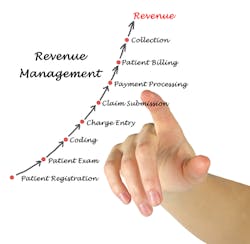Prashant Karamchandani is a director at The Chartis Group, the Chicago-based consulting firm. He helps to lead the firm’s revenue cycle management (RCM) practice, having spent two decades in healthcare. Recently, he spoke with Healthcare Innovation Editor-in-Chief Mark Hagland regarding some of the biggest challenges in the RCM area right now, and how healthcare revenue cycle management continues to evolve forward. Below are excerpts from that interview.
Hospitals and health systems are under more financial pressure than we can ever remember. What is your perspective on the current landscape?
You’re spot on there; costs are growing fast, and are definitely making things more challenging now in terms of financial viability. And the first thing people do is to say, let’s look at revenue cycle management, and where we can identify revenue leakage and recoup. And for the past four to five years, the shift to automation has become big. And we have clients who have invested in it, but the investment is often made with the promise of an ROI that you might not achieve right away. It’s not as easy as just buying a solution off the shelf; it’s got to fit into a broader strategy. The push now is on the execution of it, and how you can invest best.
Another area of focus right now is on the strategic utilization of vendors. Clients will use vendors in various different capacities; some believe they can be helpful; some don’t believe that. But in a strapped labor market, it’s not a binary decision. You could pick and choose components of your business where you want to use a vendor, and improve performance on the revenue side and decrease labor costs. So it’s about starting to think through how do I best use all the resources at my disposal.
One of the other areas has to do with process analytics and process intelligence. Revenue cycle analytics involves outcomes measures, denial rate, days in accounts receivable, how much of your accounts receivable is at greater than 90 days. I’ve made investments in solutions, in resources and people in terms of training and education, and vendors as well. And the thing is that if I overlay data on top, it should tell me how effectively I’m deploying my resources. That’s newer. That has the power to help identify where I can shift resources to. While process analytics applies to revenue cycle, it can also apply to other areas as well.
There continues to be a great deal of debate over when and how revenue cycle leaders in hospitals and health systems will reach truly advanced levels in terms of robotic process automation (RPA), and bridge over into artificial intelligence (AI) in the true sense of the term. Your thoughts?
I think we’re still early on in that journey. It depends on the area you’re in. In revenue cycle overall, we’re still in very early days. Some of the problems to solve are basic; it’s great if we can get that additional intelligence, but we’re also fixing some basic issues, including moving data from point A to point B, and removing repetitive tasks, and making the bot do it. There’s acceleration in the use of RPA, and it’s moving people towards saying, OK, what can I do next? The maturation issues are based on the organization.
Some vendors are pitching the idea that you can leverage AI and advanced RPA, and completely automate a particular process; but you can’t say that 100 percent of the time. But it’s a continuum. You’ll still need some component of staff. So how do slowly migrate? We’re not getting to fully automated revenue cycle processes tomorrow. So we’re seeing more receptivity as folks understand that it’s a journey, it’s not a binary proposition; you have to build a program around it.
What percentage of patient care organizations have begun to move into true AI?
If you segment it by business operations versus clinical, you’ll get different results. But it’s very small. Some of the vendors and industry associations will say that ‘X percentage of patient care organizations are using AI’—but to what extent? I’ve talked to clients who say they’re using RPA, but they’ve only bought the solution, but they’ve not yet done anything with it.
How will all of this evolve forward in the next few years?
COVID has done a number on revenue cycle management, but it’s pushed it to accelerate forward. Remote work has been talked about for 10-15 years, and all of a sudden, we have a pandemic now, and people flipped the switch. The majority are either keeping their teams remote or are developing a hybrid approach. And what do I need to build into my ecosystem for my team? Using automation will be a big component of it, and so will leaning on vendors to be involved in the processes. Is it through technology, better use of vendors, better recruiting? But with remote work, the talent pool has now opened up widely. And in terms of process analytics and intelligence, that’s the next step.
That’s how we manage our current-state revenue cycle management when we don’t have everyone on site and need to do everything at the lowest level of cost possible. But it has to be done strategically. You can’t just do it through purchasing software. So are we going to stay more remote? Keep growing? Consolidate our footprint? You start building a program that addresses the issues in a timely fashion. Historically, revenue cycle has been a reactive function within the organization; but the pandemic has highlighted even more that we need to be proactive. We need to respond in real time to developments. And implementing robust analytics and better technology, helps you to address issues.
And the other thing we’re seeing is the consistent battle and challenges with payers are not going away. All of these things that help me manage better also give me better intel to work with payers.
Do you have any advice for hospital and health system CIOs, around all of this?
My advice would be to continue to foster that partnership with your finance and rev cycle peers. These challenges aren’t going to go away; but making sure that these decisions will be made in tandem between the business and IT people. If one group runs out ahead of the other, you lose time. So the more you’re in lockstep, the more you’re understanding where you’re at. So now, more than ever, with everything going on, that partnership has to be fostered, strengthened, and grown.


